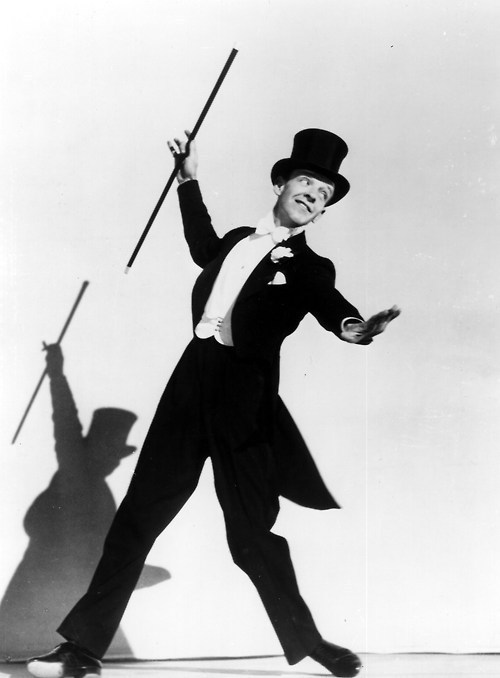It’s impossible to love musicals and not revere Fred Astaire. The epitome of elegance, Astaire was an actor, singer, choreographer, fashion icon and one of the greatest dancers in film history, whose 76 year-career encompassed 10 Broadway and West End shows, 31 musical films and dozens of recordings and TV appearances.
He entered show business early. He made his professional debut at age 6 alongside his older sister, Adele, in ‘The Wedding Cake Act’: a vaudeville routine in which they played a miniature bride and groom and danced on two large wedding cakes. Adele wore a white satin gown; Fred, a top hat and tails. Together they evolved from promising children into Jazz Age theatre stars. She was ebullient, vivacious, an inspired clown. He was an insouciant dancer who also handled most of their choreography. Audiences on both sides of the Atlantic adored them. Sadly, no footage exists of the Astaires performing together on stage. When Adele retired to get married in March 1932, Fred set off for Hollywood, where he found a new partner in Ginger Rogers and revolutionized the art of dance on film.
Astaire never seemed to dance so much as float. Each step, each gesture was a natural extension of the last—fluid, supple, meticulous. Not a single movement was superfluous. Astaire’s disarmingly simple style belied his perfectionism. He would rehearse his numbers relentlessly and was convinced that he never got them quite right. He also thought little of his singing voice, astonishing for a man who introduced many classics of the Great American Songbook. Astaire insisted on being filmed full length and choreographed his routines for long tracking shots, minimizing the number of cuts and giving his dances the seamless feel of live performances. His sense of rhythm was immaculate. In his witty and entertaining, if not exactly penetrating autobiography, Steps in Time, Astaire summed up his career as “I just dance”.
To celebrate his birthday, here are a few of my favourite numbers. The choreography is principally Astaire’s, with individual collaborators listed below.
‘Pick Yourself Up’, Swing Time (1936) Choreography: Astaire/Hermes Pan
‘Lucky’ Garnett’s (Astaire) antics have accidentally gotten dance instructor Penny (Ginger Rogers) fired. To apologise, he shows her boss how much she’s ‘taught’ him, sweeping her onto the dance floor and into a joyous, syncopated polka. Astaire and Rogers make a complicated routine look deliciously casual, tossing in little flourishes with ease. By the time they swing over the fence, you’ll be ready to leap up and join them.
‘Cheek to Cheek’, Top Hat (1935) Choreography: Astaire/Hermes Pan
Also known as the one with the feathers. Although Bernard Newman was the film’s costume designer, Rogers had a keen interest in clothes and chose her own dress for the number: a billowing gown covered in ostrich feathers. It moulted, showering the set at every twist and turn. Astaire was appalled. RKO’s seamstresses worked all night to fix the dress, but look closely at the finished sequence and you can still spot a few feathers floating around. It doesn’t matter. ‘Cheek to Cheek’ is the iconic Fred and Ginger dance—passionate, delicate and achingly romantic. As the music builds, he lifts her and she soars, then dips into a deep backbend, plunging so low her fingertips might graze the floor. No woman was ever wooed quite like this.
‘Begin the Beguine’, Broadway Melody of 1940 (1940) Choreography: Astaire/Bobby Connolly
Two tap virtuosos revelling in each other’s company. Astaire and Eleanor Powell dance with an irresistible sense of fun, playful yet precise. Halfway through, the music fades out and they break into a friendly a capella game of one-upmanship. Powell matches Astaire step for step—all shot full length in one long, unbroken take.
‘This Heart of Mine’, Ziegfeld Follies (1946) Choreography: Astaire/Robert Alton
Ziegfeld Follies is best remembered for ‘The Babbit and the Bromide’—Astaire’s historic collaboration with Gene Kelly—but he also performed three other numbers, including this one, which Harry Warrren and Arthur Freed wrote specially for him. ‘This Heart of Mine’ is a 12-minute ‘dance story’, a lavish Technicolor fairytale that could only have been produced by MGM. Astaire plays a gentleman thief who gatecrashes a ball in the hopes of relieving its guests of their valuables. He catches sight of Lucille Bremer (and her jewellery) and whisks her outside for a tête-à-tête. Astaire and Bremer glide on concealed travellators and dance on a rotating floor, surrounded by a chorus of swirling couples. Director Vincente Minnelli’s dazzling colour scheme is the perfect romantic complement.
‘You’re All the World to Me’, Royal Wedding (1951) Choreography: Astaire/Nick Castle, Sr.
Fred Astaire defies gravity. Because of course he can.
‘They Can’t Take That Away From Me’, The Barkleys of Broadway (1949) Choreography: Astaire/Robert Alton
Fred and Ginger in colour. Astaire had introduced the song in Shall We Dance, which proved to be George Gershwin’s last film before his death, aged just 38. The two men had known each other since their teens and Astaire was distraught, particularly when he learned that Gershwin’s last words had been his name. The song remained one of Astaire and Rogers’ personal favourites and they returned to it in their last film together, The Barkleys of Broadway, now accompanied by a tender routine that’s among the finest of their partnered dances. It is the only time on film that Astaire repeated a song he had performed in a previous movie.
‘Sunday Jumps’, Royal Wedding (1951) Choreography: Astaire/Nick Castle, Sr.
Fred Astaire, the only man who could dance with a hat rack and make his partner look good. This jazzy number showcases his gift for comedy, as well as his ability to take a gimmick and transform it into a fully-fledged routine. If only regular workouts were this fun.
‘Dancing in the Dark’, The Band Wagon (1953) Choreography: Astaire/Michael Kidd
Astaire conjures magic in Central Park, with nothing more than Dietz and Schwartz and Cyd Charisse.

Leave a Reply